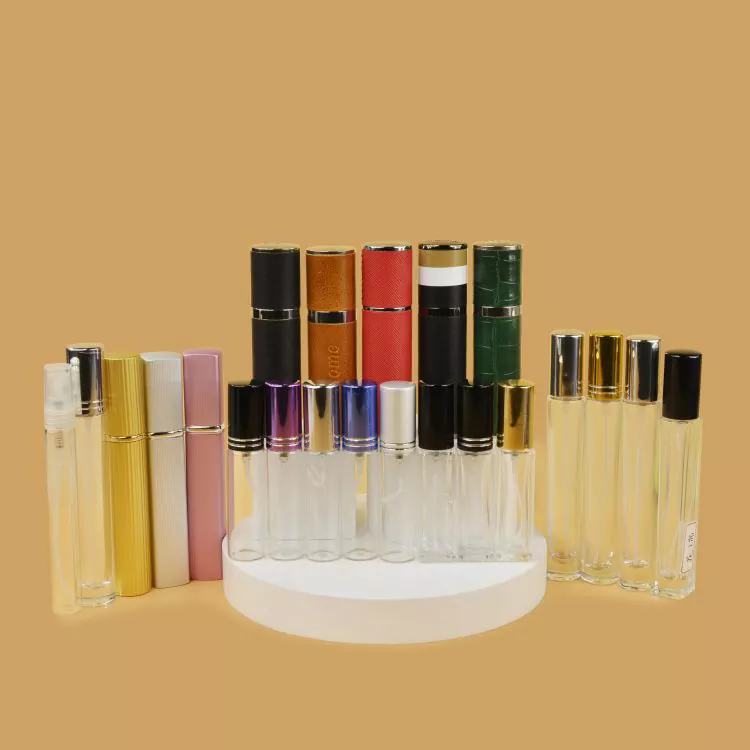Types of Perfume Bottles
2024-06-06
Perfume bottles are containers designed specifically for storing and dispensing perfumes and fragrances. They come in various shapes, sizes, and materials, and their designs often reflect the branding and aesthetic of the perfume they contain. Here's a detailed overview of perfume bottles:
Components of Perfume Bottles
1. Bottle Body: The main part of the perfume bottle, typically made of glass or plastic. It holds the fragrance liquid and often features decorative elements such as embossing, etching, or coloring.
2. Sprayer/Pump: The mechanism used to dispense the perfume from the bottle. It usually consists of a pump, tube, and nozzle, allowing users to spray the fragrance onto their skin or clothing.
3. Cap: The top or cover of the bottle, which protects the sprayer and prevents accidental leakage or evaporation of the perfume. Caps may be made of plastic, metal, or other materials and often feature decorative elements or branding.
4. Collar: The part of the bottle that connects the pump/sprayer to the bottle body. It provides a secure attachment and ensures proper functioning of the dispensing mechanism.
5. Labeling: Perfume bottles typically have labels or decals affixed to the bottle body, providing information such as the fragrance name, brand, concentration, and ingredients.
Types of Perfume Bottles
1. Glass Bottles: Commonly used for high-end and luxury fragrances, glass bottles offer a premium look and feel. They come in various shapes, including rectangular, cylindrical, square, and novelty designs.
2. Plastic Bottles: Plastic bottles are lightweight, durable, and less prone to breakage than glass bottles. They are often used for mass-market perfumes and travel-size bottles.
3. Atomizer Bottles: These bottles feature a bulb or pump mechanism that allows users to dispense the perfume as a fine mist or spray. Atomizer bottles are popular for their convenience and ease of use.
4. Roll-On Bottles: Roll-on bottles feature a rollerball applicator attached to the bottle's opening, allowing users to apply the perfume directly to their skin with precision. They are commonly used for oil-based perfumes and fragrances.
5. Decanter Bottles: Decanter bottles are typically large, decorative bottles used for storing and displaying perfume in homes or dressing rooms. They often have intricate designs and may serve as decorative pieces.
Design Considerations
1. Brand Identity: Perfume bottles play a crucial role in brand identity and marketing. The design, shape, and materials of the bottle should reflect the brand's image and appeal to the target audience.
2. Aesthetic Appeal: Perfume bottles are often designed to be visually appealing and evoke emotions or associations related to the fragrance. The bottle's design should complement the fragrance's scent and theme.
3. Functionality: While aesthetics are important, perfume bottles must also be functional and practical. The dispensing mechanism should be easy to use, reliable, and durable.
4. Packaging: Perfume bottles are often packaged in boxes or cases for retail display and transportation. The packaging should protect the bottle from damage and enhance its presentation.
Trends and Innovations
1. Customization: Brands are offering personalized perfume bottles, allowing customers to customize the bottle's design, engraving, or packaging to create unique and memorable gifts.
2. Sustainability: There is a growing trend toward sustainable and eco-friendly perfume packaging, with brands using recycled materials, biodegradable plastics, and refillable bottle designs to reduce environmental impact.
3. Limited Editions: Brands release limited-edition perfume bottles with unique designs or packaging to create exclusivity and generate excitement among consumers.
4. Technological Integration: Some perfume bottles feature technological innovations such as LED lights, digital displays, or smart sensors that enhance the user experience or provide additional functionality.
Conclusion
Perfume bottles are not just containers for storing fragrances but also important elements of branding, marketing, and user experience. With their diverse designs, materials, and dispensing mechanisms, perfume bottles serve as both functional and aesthetic objects that enhance the appeal and allure of the fragrances they contain. By understanding the components, types, design considerations, and trends in perfume bottles, brands can create captivating and memorable packaging for their perfumes.



